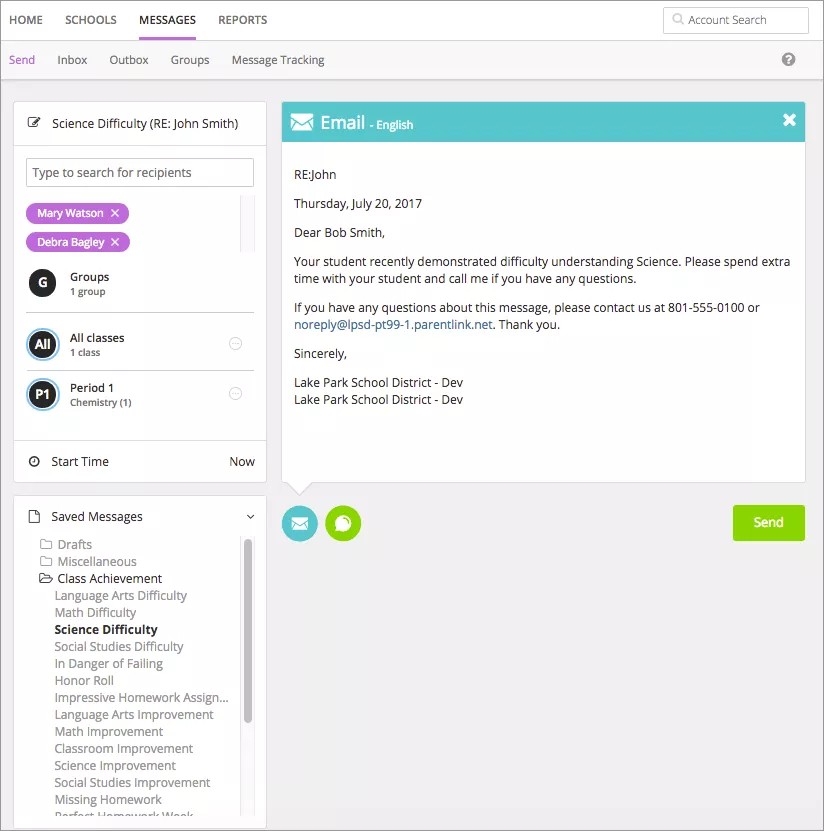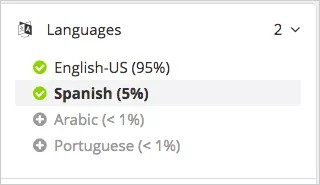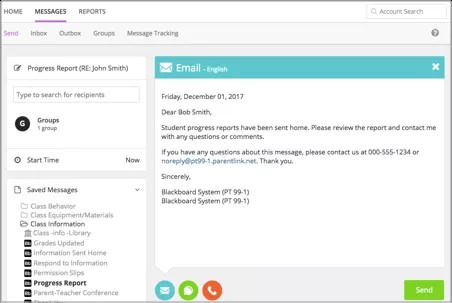Communicate effectively.
Your school's website includes a simple-to-use notification system that is designed for teachers — Teacher Communications. You can send messages to any of your students, the entire class, all your classes, or just to parents. Plus, Teacher Communications allows you to send pre-made messages. These messages are categorized into teacher specific categories and can be targeted to select students based on the message subject. You can also create your own message.
Check it out!
Send my own message
If you want to create your own message instead of sending a pre-made message, you can type your own content in Send Message page. You can then select to send it as an email, text/SMS message, or if set by your school, as a phone message.
- Select Messages.
Each teacher's students are separated into classes.
- Select the class or a user group.
Is there a group of students or parents that you contact on a regular basis? Create a special user group!
- To send a message to one or a few members, select the specific users. You can select all parents or all students, or use the list icon to select individual users. You can also search for specific users by name.
- Type the Subject.
- Select one or more delivery methods from the main send message page to send to the recipients:
- Emails - Type your text and add any images. To remove the email option, close out the tab from the upper right hand corner.
- Text/SMS - Content needs to be less than 160 characters. To copy content from the email message, select the Copy Content icon. To remove the text/SMS option, close out the tab from the upper right hand corner.
- Select Start Time to change the time to send the message. If you want to repeat message, you can also add more dates and times. You cannot send messages during your school's blackout times.
- Include language translations by selectingLanguage, and select each language needed.
You can remove any language with the Delete icon.
Amheric language will not include translation or text-to-speech capabilities. Some Android devices and iOS do NOT support Amheric, and the message may not look correct on those devices. However, it is expected that those users requiring Amheric language will use phones that support the display.
If needed, check the text message option if over the character limit.
- Select Send when finished.
Send a pre-made message
Pre-made messages allow you to quickly send standard, student-type messages to students in your classes or specific user groups you created. There are several you can choose from.
- System created: Written and recorded in four supported languages: English, Spanish, Portuguese, and Haitian-Creole. Can't be edited, copied, or deleted. Identified by the Blackboard logo.
- Admin created: Created by your district administrator. Can be copied only. Identified by an image of a building.
- User created: Written and recorded by a user. Can be edited, copied, and deleted. Identified by an image of a person.
All of the system pre-made teacher messages are available in several languages including English, Spanish, French, German, Mandarin, and Cantonese. Any of these messages will send in the preferred language of the recipient if available.
Messages will deliver at the optimal start time set by the school or district, and will also adhere to the school or district call window. Contact the school administrator about the teacher message delivery times at each school.
-
Select Messages.
Each teacher's students are separated into classes.
- Select the class or a user group.
- To send a message to one or a few members, select the specific users. You can select all parents or all students, or use the list icon to select individual users. You can also search for specific users by name.
- Select a message category from the Saved Messages list.
Category examples may include Class Achievements, Class Behavior, or Class Projects.
- Select the messages to use. The message will appear in the Send Message page.
- Type the Subject.
- Select one or more delivery methods from the main send message page to send to the recipients:
- Emails - You can update the text and add any images. To remove the email option, close out the tab from the upper right hand corner.
- Text/SMS - Content needs to be less than 160 characters. To remove the text/SMS option, close out the tab from the upper right hand corner.
- Select Send when finished.
What if I want to send a phone message?
By default, teachers cannot send phone messages unless the feature has been turned on by your district. If it is available, a phone icon will be available on the Send Message page. You can record audio to attach to your message. You can use your school's phone system to record the message, upload an audio file you created, or type text that will translate to speech. You select your recording option from the Phone list when creating a new message.
- If you select Call me to record, type your phone number and select Call me to record.
- If you select Call In to record, follow the on-screen instructions to record the message.
- Call the number listed.
- Immediately enter the unique four-digit code.
- Record the message after the prompt.
- Press pound # when finished.
- Select from the menu options:
- Press 1 to save the message.
- Press 2 to listen to the message.
- Press 3 to re-record the message.
- When satisfied with the message, press 1 and wait for the confirmation message before hanging up.
- If you select Upload Audio file, select Browse to find and upload your recorded audio file.
- If you select Text to Speech, type your message in the Text messages box. Select Play Audio to listen to the message, or type your phone number and select Call to hear your message.
Create accessible messages
Toegankelijke berichten maken
Wist u dat 1 miljard mensen ter wereld een geestelijke of lichamelijke beperking hebben? Of dat 12,9% van alle studenten in Noord-Amerika een beperking heeft? Het belangrijk om ervoor te zorgen dat al je studenten en leden van de gemeenschap je berichten begrijpen.
Meer over toegankelijkheid in onderwijs
Toegankelijkheidtips voor alle berichten
Het maakt niet uit of je een e-mail stuurt of Facebookbericht plaatst; je kunt je berichten eenvoudig toegankelijk maken aan de hand van deze toegankelijkheidstips.
- Schrijf duidelijk. Houd je zinnen kort. Gebruik woorden, of combinaties van woorden, met 1-2 lettergrepen indien mogelijk. Gebruik samentrekkingen. Gebruik tools zoals de Hemmingway Editor om de leesbaarheid van uw tekst te meten.
- Gebruik niet alleen lettertypestijlen en -kleuren om tekst te benadrukken! Als je een sterk visueel signaal wilt afgeven, gebruik dan ook een alternatieve aanduiding, Gebruik een uitroepteken aan het einde van een belangrijke zin. Uitroeptekens en vraagtekens worden namelijk wel geïnterpreteerd door schermlezers. Dit houdt in dat de tool het ‘vraagteken’ niet leest, maar in plaats daarvan een vragende toon gebruikt terwijl de vraag hardop wordt voorgelezen.
- Voeg alt-tekst toe aan je afbeeldingen. Je hoeft niet "Afbeelding van" te zeggen, aangezien de ondersteunende tools al weten dat het een afbeelding is. Wees beknopt, duidelijk en beschrijvend. Gebruik niet dezelfde alt-tekst voor elke afbeelding, zoals "Afbeelding ter illustratie van bijbehorende tekst". Het is nutteloos en voegt overbodige elementen toe.
- Voeg ondertitels voor afbeeldingen toe wanneer je geen alt-tekst kunt toevoegen. Als je geen alt-tekst aan uw afbeeldingen kunt toevoegen, zorg dan dat je tekst alle informatie bevat. Dit moet duidelijk zijn zonder de afbeelding.
- Maak koppelingen beschrijvend. Elke koppeling moet een beschrijving geven van wat gebruikers kunnen verwachten wanneer ze op de koppeling klikken. Vermijd het gebruik van algemene zinnen zoals "klik hier" of "zie meer". Webadressen of URL's worden niet als informatief beschouwd en moeten dan ook niet worden gebruikt. Maak de tekst in plaats daarvan beschrijvend.
- Maak je bijlagen toegankelijk. Gebruik dezelfde tips om je bijlagen toegankelijk te maken. Zie Toegankelijkheid bij Blackboard voor meer informatie.
- Voeg gesloten ondertitels of transcripts toe aan je video's. Vermeld een koppeling naar transcripts als je video geen gesloten ondertitels bevat.
- Luister naar je bericht om er zeker van te zijn dat het klopt. Gebruik tekst-naar-spraaktools om je bericht te beluisteren, voordat je het verstuurt. Deze tools zijn beschikbaar op de meeste apparaten.
Toegankelijkheid in social media
Social media is niet altijd toegankelijk. Gebruikers van schermlezers kunnen soms lastig navigeren. Daarnaast heeft inhoud niet altijd titels, alt-tekst voor afbeeldingen of ondertiteling van video's. Dit betekent niet dat je social media niet kunt gebruiken. Hierop is je doelgroep te vinden. Zorg dat je inhoud zo toegankelijk mogelijk is, zodat je je hele doelgroep kunt bereiken.
Gebruik de toegankelijkheidstips voor al je inhoud en de volgende tips wanneer je Facebook of Twitter gebruikt.
- Geef een tekstalternatief voor alle foto's en afbeeldingen die je plaatst.
- Vermeld een koppeling naar transcripts wanneer je een video plaatst.
- Vertel je doelgroep wat er in je tweet staat. Gebruik deze voorvoegsels aan het begin van je tweet als deze foto's, video's of audio bevat.
- Foto's: [PIC]
- Video’s: [VIDEO]
- Audio-bestand: [AUDIO]
- Gebruik hashtags en vermeldingen aan het einde van de tweet.
- Gebruik CamelCase in hashtags. Schrijf de eerste letter van ieder woord in je hashtag met een hoofdletter. Bijvoorbeeld: #BlackboardToegankelijkheid
- Vermijd tekstjargon dat mogelijk raar klinkt wanneer een schermlezer dit leest.




